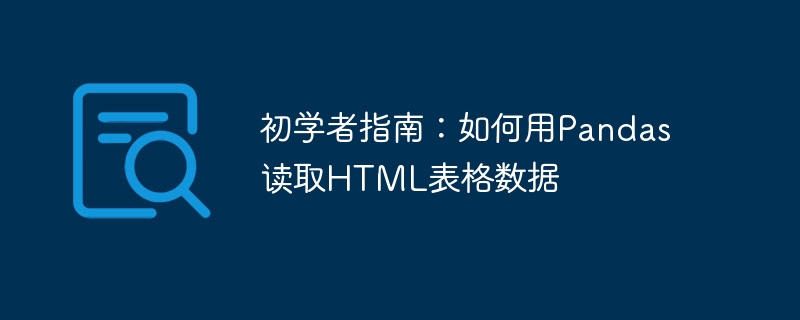Home >Backend Development >Python Tutorial >Pandas Beginner's Guide: HTML Table Data Reading Tips

Beginner’s Guide: How to read HTML table data with Pandas
Introduction:
Pandas is a powerful Python library for data processing and analysis. It provides flexible data structures and data analysis tools, making data processing simpler and more efficient. Pandas can not only process data in CSV, Excel and other formats, but can also directly read HTML table data. This article will introduce how to use the Pandas library to read HTML table data, and provide specific code examples to help beginners get started quickly.
Step 1: Install the Pandas library
Before you begin, make sure you have installed the Pandas library in your Python environment. If it is not installed yet, you can install it with the following command:
pip install pandas
Step 2: Understand the HTML table structure
Before using Pandas to read HTML table data, we need to understand the structure of the HTML table. HTML tables start with a table tag (table), each row is wrapped with a row tag (tr), and each cell is wrapped with a column tag (td). The following is a simple HTML table example:
<table>
<tr>
<th>姓名</th>
<th>年龄</th>
<th>性别</th>
</tr>
<tr>
<td>小明</td>
<td>20</td>
<td>男</td>
</tr>
<tr>
<td>小红</td>
<td>22</td>
<td>女</td>
</tr>
</table>Step 3: Use Pandas to read HTML table data
Pandas provides the read_html() function, which can read table data directly from HTML files or URLs. The following is a sample code for reading HTML table data:
import pandas as pd
# 读取本地HTML文件
df = pd.read_html('your_filepath.html')[0]
print(df)
# 从URL中读取HTML表格数据
url = 'http://your_url.com'
df = pd.read_html(url)[0]
print(df)In the above code, we read the HTML table data through the read_html() function and store it in a Pandas DataFrame object. [0] means that we only read the first table. If there are multiple tables in the page, you can select the table index to read as needed.
Step 4: Process and analyze HTML table data
Once the HTML table data is successfully read, we can use various functions and methods provided by Pandas to process and analyze the data. The following are some commonly used data manipulation examples:
View the first few rows of the table
print(df.head())
View the column names of the table
print(df.columns)
View the number of rows and columns of the table
print(df.shape)
Filter data
# 筛选年龄大于等于20岁的数据 filtered_data = df[df['年龄'] >= 20] print(filtered_data)
Statistics
# 统计年龄的平均值、最大值和最小值 print(df['年龄'].mean()) print(df['年龄'].max()) print(df['年龄'].min())
Sort data
# 按照年龄从大到小对数据进行排序
sorted_data = df.sort_values('年龄', ascending=False)
print(sorted_data)The above is just a small part of the sample code. Pandas provides very rich data processing and analysis functions. You can Use relevant functions and methods according to specific needs.
Summary:
This article introduces how to use the Pandas library to read HTML table data, and gives specific code examples. By learning and mastering these methods, beginners can process and analyze HTML table data more easily and improve data processing efficiency. I hope that the introduction in this article can help beginners who need to use Pandas to read HTML table data.
The above is the detailed content of Pandas Beginner's Guide: HTML Table Data Reading Tips. For more information, please follow other related articles on the PHP Chinese website!